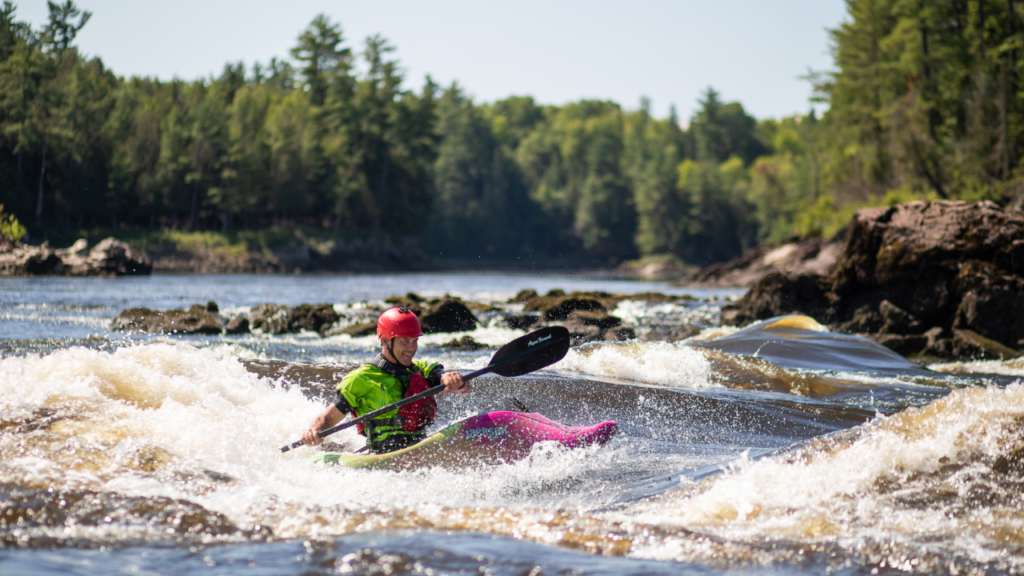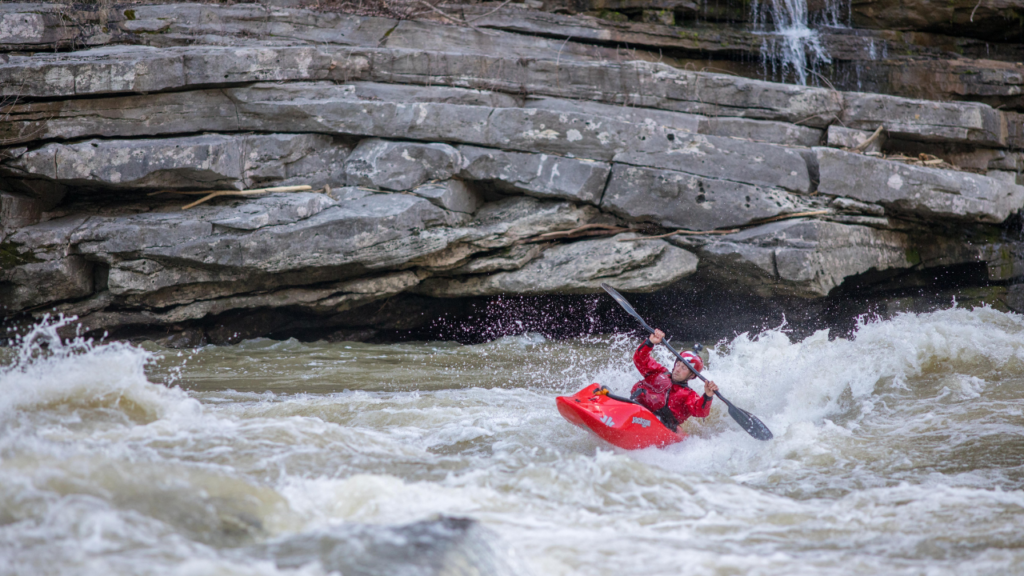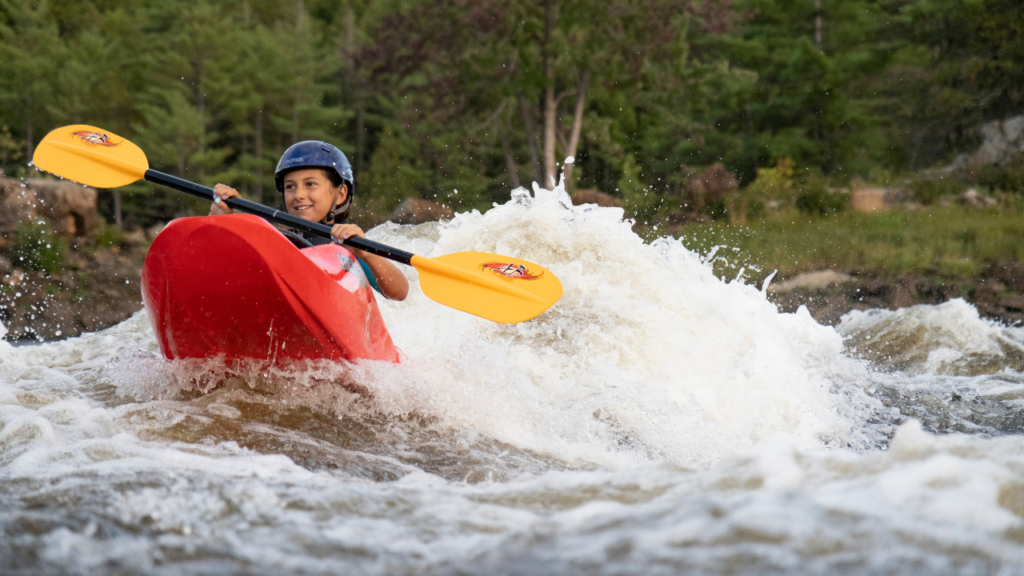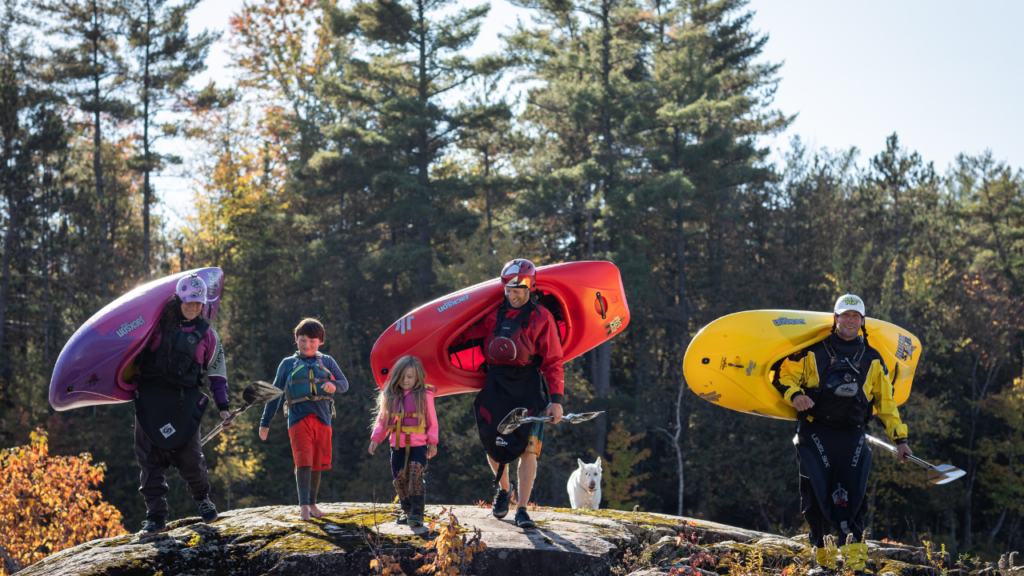Do you have an adventurous side? How about a positive attitude? Can you handle getting a little wet? Then you should try whitewater kayaking. Contrary to popular opinion, I think these are the only true requirements for delving into this aspect of the sport.
Many people see whitewater kayaking on TV, or maybe watch some highlight reels on YouTube, and are impressed, but turned off from trying it themselves because it looks too extreme. Well, hurling yourself off a waterfall is sort of the “Everest” of whitewater kayaking, and yes, something best reserved for professional daredevils.
But, there is also the “day-hike” equivalent – something that is both safe and enjoyable. So let’s get into what’s great about whitewater kayaking and answer some common questions that beginners tend to have.
The Benefits of Whitewater Kayaking
1. Sweet kayaking skills!
Learning to navigate whitewater conditions will give you a new set of tools that will translate into all other types of kayaking and paddling that you like to do. These abilities will also make you a more confident and safe paddler in a recreational kayak, SUP or sea kayak.
2. River dynamics and reading water
Another transferable development that will come from whitewater kayaking is an appreciation for the power of moving water – not just whitewater, but any strong current. This will further enhance your safety awareness when you are paddling on the ocean with strong currents.
3. You’ll have a lot of fun!
Not only will conquering the rapids make you a more proficient, more confident, and safer paddler, but you’re guaranteed to have a good time doing it.

Top 5 Questions About Getting Into The Sport
1. Is whitewater kayaking for me?
I think that whitewater kayaking requires a person to be game for adventure, comfortable with water, and to be reasonably fit. It’s also important to understand and accept that there are some inherent risks, though this doesn’t mean that whitewater has to be dangerous.
To use biking as an analogy, recreational paddling is like cycling on a paved road, whereas whitewater kayaking is comparable to mountain biking. Anyone familiar with mountain biking knows that this term includes gentle trails, gnarly descents, and everything in between. What kind of route you choose is up to you. Where the analogy drops away is in regards to the potential consequences. If you wipe out while mountain biking, even on an easy trail, the hard ground might cause some injuries.
Whereas with whitewater kayaking, a spill usually just means getting soaked. Of course, to be fully transparent, anytime water is involved, and more-so with current and rougher conditions, drowning is a possibility. But this risk can be greatly mitigated by learning the ins and outs of the sport, and by practicing in easier settings.
2. When to start whitewater kayaking
In terms of age, my daughter started when she was 9 years old. She then took the reins in her own kayak when she was 11. And then on the other end of the spectrum, I’ve taught people in their 70s how to run the rapids. As long as the rate of progress is appropriate to the physical capabilities of the paddler, then just about anyone who is excited for the challenge should be able to get out there.

3. Is whitewater kayaking dangerous?
To continue on with this discussion, it’s important to understand that there is some level of risk with all sports. And anytime you head out into the wilderness, there will be extra dangers to consider. Thankfully, there are things within your control that can help mitigate the risks involved in whitewater kayaking. The most important thing is to get professional instruction!
Take a course in whitewater kayaking
I got started with a 5-day course that not only gave me the proper know-how, but also made me fall in love with whitewater kayaking. I actually ended up taking another course shortly after, and by that point, I had found an awesome community of like-minded paddlers to grow with.
Stay within your comfort zone
Once you know what you’re doing, the level of risk depends on if you stay within your comfort zone, or decide to push your limits. Most whitewater paddlers that I know stick to lower classes of rapids, and largely do so in order to open up a massive world of routes/experiences that flat-water paddlers wouldn’t be able to access.
Get help reading and reacting to the different classes of whitewater
Some people encounter unexpected rough sections and decide to push through, without knowing the proper techniques. This can certainly be dangerous. So once again, getting professional instruction on how to deal with whitewater can be a huge asset for all paddlers, even if you don’t intend on vigorously pursuing the rapids.

4. Can I get trapped in the kayak if I flip?
It’s theoretically possible, but highly unlikely if you’re comfortably fitted into the kayak and have practiced the “wet exit” with supervision. Once you have dunked and then surfaced (which only takes about 2 seconds), you’ll see how easy it actually is. That being said, I can understand why people might be concerned about getting stuck.
A good whitewater kayak feels comfortably snug, there are hip pads and thigh hooks to keep you anchored (when you want to be), a supportive seat, and a skirt to cap it all off. But the skirt has a rip-cord, is still easy enough to pull off if you can’t find it in the moment (or if you tuck it inside by accident), and when you flip, gravity naturally wants your body to exit the boat.
If you’re newer to whitewater and are nervous about getting stuck, you can opt for a skirt that goes on easily (which also means it comes off easier), and outfit your kayak so that everything is a bit looser. A little wiggle room isn’t an issue, especially if it brings you more peace of mind. As your skills, confidence, and goals progress, then you can look at tighter/more aggressive customizations.
5. Do you need to learn how to roll a kayak?
It depends on what your goals are. For example, if your aim is to be able to push through Class 1 and 2 rapids as part of a multi-day paddling trip, then no, you don’t need to learn how to roll a kayak.
But if you want to pursue more intensive and exciting whitewater kayaking, then yes, you absolutely need to learn this skill. In fact, next to wearing a life jacket and helmet, I consider a proficient roll to be one of your most important safety tools.
Learning to roll the kayak will save you a lot of hassle compared to if you have to swim out each time you flip. And nailing the roll will be a major boost to your confidence and overall enjoyment. I recommend popping in some good ear plugs (to prevent ear infections) and hammering out your kayak roll until you feel confident doing it anytime, anywhere.

Take a course in whitewater kayaking!
As I mentioned before, I think the best way to get started is to take a whitewater kayaking course with quality, professional instructors. They will get you properly outfitted and steadily increase the challenges as your skills progress. Another cool option is to take some pool lessons. You’ll be able to hone the craft in a controlled environment.
Give whitewater rafting a try
And finally, if you just want a taste of the whitewater experience, you can sign up for a rafting tour. This will make for a fun, wet, and adrenaline-fuelled afternoon, without having to invest fully in the sport.
Whitewater kayaking for beginners
So that’s my pitch for why you should give whitewater kayaking a shot. If you’ve been curious, but also a little trepidatious, then I hope this information sets your mind at ease, and gets you excited for your first attempt. Learning to thrive in the rough stuff really will make you a better paddler, and I think you’ll have a lot of fun too. Good luck out there, and until next time, check out more videos on PaddleTV to discover even more exciting paddling content.
Big thanks to Jackson Kayaks for sponsoring my segments on whitewater kayaking. They continue to be a leader in the sport, making whitewater kayaks to get beginners started, as well as models to help elite paddlers push past apparent boundaries. I recently did a full review of the Antix 2.0 that you can check out here.
Take a free online safety course for canoeing, kayaking, and stand up paddling (SUP), brought to you by the American Canoe Association and the U.S. Coast Guard: https://americancanoe.org/education/resource-library/paddlesports-online-course/
Other paddling gear I use and recommend
NOTE: These are affiliate links where I’ll earn a small commission if you make a purchase at no additional cost to you, but it’s a great way to show your support. Thanks!
FOOTWEAR
| Brand | Product | Our Review | Price | BUY NOW |
|---|---|---|---|---|
| NRS | Kicker Remix Shoe | 52.95 | Buy Here | |
| NRS | Boundry Boot | 104.95 | Buy Here |
PADDLING SHIRTS / TOPS
| Brand | Product | Our Review | Price | BUY NOW |
|---|---|---|---|---|
| NRS | Men's Guide Long Sleeve Shirt | Best Kayak Gear and Canoe Gear 2022 | 89.95 | Buy Here |
| NRS | H2Core Silkweight Shirt | 44.95 | Buy Here | |
| NRS | H2Core Silkweight Long Sleeve Shirt | 54.95 | Buy Here | |
| NRS | Hydroskin Short Sleeved Shirt | 94.95 | Buy Here | |
| NRS | Riptide Splash Jacket | 229.95 | Buy Here | |
| NRS | Benny Board Shorts | 64.95 | Buy Here | |
| NRS | Hydroskin Shorts | 74.95 | Buy Here | |
| NRS | Flux Dry Top | 399.95 | Buy Here | |
| NRS | Axiom Dry Suit | NRS Axiom Dry Suit Review: How do I choose a dry suit? | 1295 | Buy Here |
| Level Six | Emperor Dry Suit | Level Six Emperor Drysuit Review | 960 | Buy Here |
PFD’S – LIFE JACKETS
| Brand | Product | Our Review | Price | BUY NOW |
|---|---|---|---|---|
| NRS | Odyssey PFD | 149.95 | Buy Here | |
| NRS | Zen PFD | 229.95 | Buy Here |
OTHER PADDLING GEAR
| Brand | Product | Category | Our Review | Price | BUY NOW |
|---|---|---|---|---|---|
| Zoleo | Satellite Communicator | Navigation | Zoleo Satellite Communicator Review | 199 | Buy Here |
| NRS | Drylander Sprayskirt | Spray Skirts | 104.95 | Buy Here | |
| WRSI | Current Helmet | Helmet | 119.95 | Buy Here | |






